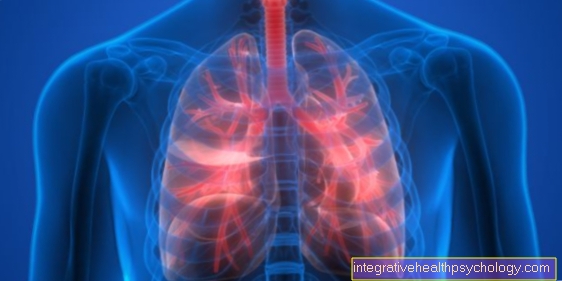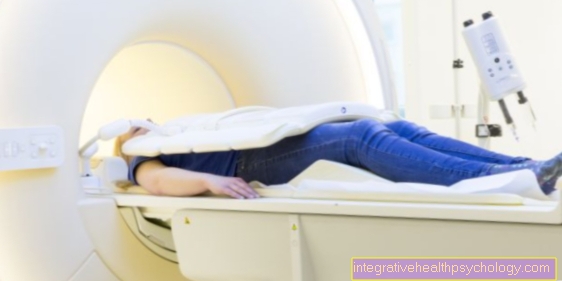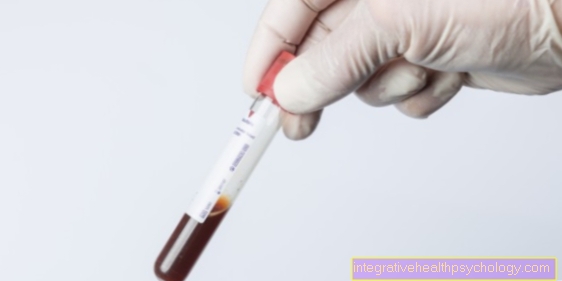Stages of COPD
introduction
COPD is a chronic obstructive pulmonary disease. Depending on the severity of the disease, different stages of COPD can be distinguished.
The division into stages provides doctors with information about the patient's health and complaints and the progress of the disease. This will help make a decision about what treatments are needed.

One of the classifications is based on the results of a lung function diagnosis (Spirometry).
Another division into stages comes from the Global Initiative for Chronic Obstructive Lung Disease (GOLD). This takes into account in addition to certain lung function parameters (FEV1 and Tiffneau index) and the severity of symptoms. This is done with the help of special standardized questionnaires and the number of acute worsening COPD (so-called Exacerbations) detected.
How many stages are there?
There is a classification that is based solely on testing lung function. According to this, the classification is made into four degrees of severity (I, II, III, IV). The patient's symptoms are not critical to this classification. The interpretation of measurement data of the lung function for staging is only possible if there is no acute deterioration of the COPD at the time of the measurement (Exacerbation) is present.
Another classification according to the Global Initiative for Chronic Obstructive Lung Disease (GOLD) takes into account not only the results of spirometry but also the severity of the patient's symptoms with the help of standardized questionnaires. This division is also made in four stages (GOLD A, GOLD B, GOLD C and GOLD D).
Stage 1
Stage 1 COPD is when spirometry of the lungs (lung function diagnostics) shows a one-second capacity (FEV1, Forced Expiratory Volume per second) of over 80 percent of the normal value. This is the tidal volume that can be exhaled again within the first second after maximum inhalation with full force. This value allows conclusions to be drawn about a possible narrowing (obstruction) the airways.
The is of additional interest when evaluating spirometry in COPD patients Tiffneau index. This is also known as the relative one-second capacity and results from the ratio of the FEV1 to a further specific lung volume (vital capacity, lung volume between maximum inhalation and maximum inhalation).
Typical symptoms of COPD are chronic cough, expectoration due to increased mucus production and shortness of breath.
In this “mild” stage of COPD, however, it is still possible that neither chronic cough nor increased mucus production is present.
A shortness of breath, the so-called Dyspnea, is often not consciously perceived by the patient at this stage.
In the early stages, the disease is often mistaken for a "smoker's cough" or a slight respiratory infection. Since there are usually no impairments in everyday life, the affected patients are often not yet aware that they suffer from a chronic obstructive pulmonary disease.
Further information on this topic can be found at: Pulmonary function test
Stage 2
Stage 2 is a moderate or moderate form of COPD.
At this stage there is a shortness of breath, a so-called Dyspnea, only when loaded. It is also possible that patients who are not very active in sports and generally live relatively little exercise do not notice any deterioration in their state of health.
The one-second capacity (FEV1) measured in the spirometry is 50-80 percent of the normal value in the second stage.
Symptoms of COPD such as chronic cough and sputum are more pronounced, but in some cases may be absent. Coughing up sputum in the morning is typical. This is coughed up and slimy secretion.
However, a lack of sputum or only small amounts of sputum do not rule out COPD.
Stage 3
If the third stage of COPD is reached, it is already a severe form.
In this case already has a large number of alveoli, also called Alveoli referred to, lost their functionality.
The one-second capacity measured in the spirometry is only 30 to 50 percent of the normal value in the third stage. The one-second capacity (FEV1) is a tidal volume that can be exhaled within the first second after maximum inhalation. The one-second capacity allows conclusions to be drawn about a possible narrowing (obstruction) the airways.
The main symptoms of COPD, chronic cough and sputum, are more noticeable in the third stage of the disease.
Even minor physical exertion, such as climbing stairs or walking for a long time, can cause those affected to breathe heavily.
Many patients also have problems coughing up secretions (sputum) in the morning. At this stage, those affected may already have cardiovascular problems. These can arise as a result of chronic oxygen deficiency.
If symptoms occur, a doctor should be contacted and the symptoms clarified by a doctor. Even at this stage, there are still few patients who suffer little or no from the symptoms mentioned above. It can therefore happen at this point in time that those affected are not yet aware of a chronic obstructive pulmonary disease.
Stage 4
If the one-second capacity measured in the spirometry is below 30 percent of the normal value, the disease is already very advanced and COPD is in the fourth stage, which is also the end stage.
At this point in time, patients are chronically undersupplied with oxygen. They suffer from severe shortness of breath even when they are resting, which is why their physical resilience is very limited. In addition, the patients suffer from a severe chronic cough with sputum.
Since COPD is a systemic disease that stresses the entire organism, it can lead to many other diseases. Especially in patients with high stages of COPD who have already had a long history of the disease, there is often another disease that requires treatment.
In older patients there are often several. This is due to the fact that the COPD is related to a strong physical stress and thereby the entire organism is weakened.
This causes secondary diseases such as cardiovascular weakness, right heart failure (Cor pulmonale), Diabetes, or osteoporosis are more likely. In addition, severe weight loss can occur at an advanced stage, which in turn leads to a loss of muscle mass and bone density and an increase in insulin resistance, which then increases blood sugar.
To break this vicious circle, it is important to counteract weight loss with appropriate nutrition. In addition, so-called exacerbations pose a life-threatening threat to the patient in late stages. Exacerbations are the acute flare-ups of chronic obstructive pulmonary disease.
If there is already a respiratory insufficiency, the affected person is supplied with oxygen through a nasal cannula as part of oxygen therapy (LOT). This enables the patient to expand their range of motion (play).
In addition to improving the quality of life, oxygen therapy leads to an increase in life expectancy.
In the case of very severe forms of COPD, surgery, such as a lung transplant or a reduction in lung volume, can also be considered for certain patient groups at this stage. This is an attempt to counteract the constant overinflation of the lungs.
Read more on this topic at: Symptoms of COPD
GOLD classification
The Global Initiative for Obstructive Lung Disease (GOLD) classifies the lung disease COPD into four degrees of severity. The disease state is determined with the help of certain lung function parameters, the one-second capacity (FEV1) and the Tiffneau index, by spirometry.
The severity of symptoms and the number of previous acute episodes of disease are also important for the classification into the stages according to GOLD (Exacerbations).
Certain questionnaires serve as an aid to recording the severity of symptoms. This is the mMRC dyspnea scale (Modified Medical Research Council), which shows the severity of shortness of breath and the impact on everyday activities CAT (COPD Assessment Test). The CAT is discussed in detail below.
The aim of the GOLD classification is to standardize the treatment of COPD worldwide and to adapt the therapeutic steps to the stage of the disease of the person affected.
CAT Score
The COPD Assessment Test (CAT) contains eight questions about the symptoms and their severity, which must be answered by the patient. The questions relate to the frequency of coughing, the mucus build-up, the presence of a feeling of enfeeblement in the chest, the physical resilience, everyday skills, sleep quality and the patient's well-being. For each question, depending on the severity of the complaint, a number of points from zero to five points can be awarded. The points will then be added up in the evaluation. This results in a possible score of a minimum of 0 and a maximum of 40 points.
How do the stages affect life expectancy?
Life expectancy in chronic obstructive pulmonary disease (COPD) depends on many different individual factors. In addition to the severity or stage of the COPD, this also includes the age of the patient and the results of the lung function measurement.
In addition, it becomes noticeable in the lifetime how consistently the therapy plan is adhered to at every point in the disease.
In general, it can be said that the lifespan of a person suffering from COPD is significantly reduced.
With regard to the life expectancy of COPD, however, it can generally be said that the progression of the disease is difficult to predict and that in individual cases this can deviate significantly from the statistically expected course.
Read more on this topic at: Course of COPD
This is due to the fact that the course of the disease can be influenced by many different factors. However, it can be said that an increasing loss of lung function has a negative effect on prognosis and life expectancy.
The FEV1 value (the one-second capacity) determines the division into degrees of severity. The lower the FEV1 value, i.e. the more it deviates from the target value, the higher the stage of COPD and the lower the life expectancy.
Read more on this topic at: Life expectancy in COPD
Degree of severe disability by stage
Depending on the stage of the disease, COPD can lead to severe impairments in everyday life and the need for help. Those COPD patients who are severely disabled according to the Social Security Code or who have a degree of disability of at least 50 percent can apply for a disability card.
Usually this affects patients from COPD stage III. The responsible pension office (Office for Social Affairs) determines the degree of disability.
A severely handicapped ID card leads to tax relief, offers special protection against dismissal and some special rights at work. However, COPD patients are only entitled to a disabled parking permit in exceptional cases.
Further information- Therapy of COPD
- Course of COPD
- Pulmonary function test
- Breathing exercises for COPD
You can find an overview of all topics in the field of internal medicine under: Internal medicine A-Z
















.jpg)












